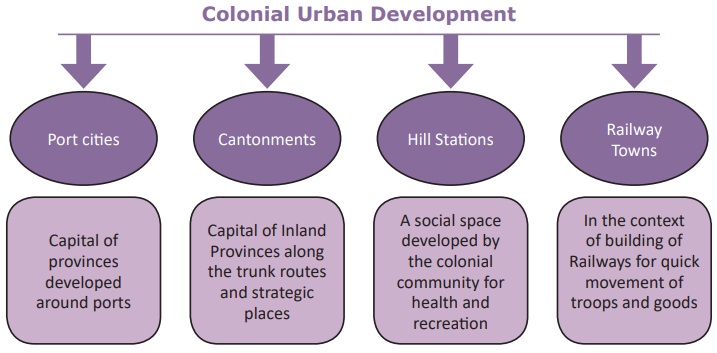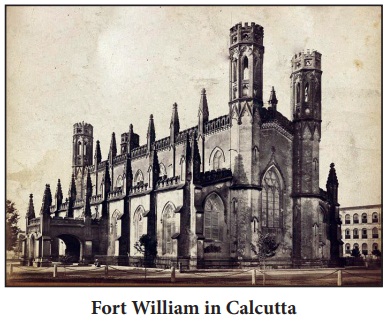Urban changes during the British period | Chapter 7 | History | 8th Social Science - Unique features of urbanisation under the British | 8th Social Science : History : Chapter 7 : Urban changes during the British period
Chapter: 8th Social Science : History : Chapter 7 : Urban changes during the British period
Unique features of urbanisation under the British
Modern towns
With the arrival of Europeans
brought about new changes in the development of towns. They first developed
some coastal towns such as Surat, Daman, Goa and Pondicherry. The British after
consolidated their power in India developed three main cities - Mumbai, Chennai
and Kolkatta as the administrative headquarters and trading centres. With the
extension of domination they developed new towns, depending on its location,
purpose and resources. The newly developed towns are known differently as hill
towns, industrial towns, court towns, railway station towns, cantonments and
administrative towns.
Unique features of urbanisation
under the British
I. De-industrialisation
In the beginning of eighteenth
century, the policies of the British proved harmful to the process of
urbanisation. Later, the economic policies followed by the British led to the
rapid transformation of India’s economy into a colonial economy and development
of cities.
With the help of one–way free trade
predominance of British, Indian manufacturing industries were destroyed. The
effect of this wholesale destruction of the Indian manufacturing industries,
led to the ruin of the millions of artisans and craftsman. There was a sudden
collapse of the urban handicrafts industry which had for centuries made India’s
name in the markets of the entire civilised world.
Towns and cities long famed for
their specialized products gazed continually shrinking market. As a result, old
populous manufacturing towns such as Dacca, Murshidabad, Surat and Lucknow lost
their previous importance. The entire industrial structure crashed down under
stiff competition of imported goods.
The traditional industrial base of
Indian cities, made by the indigenous handicraft production was destroyed by
Industrial revolution. The high import duties and other restrictions imposed on
the import of Indian goods into Britain and Europe led to the decline of Indian
industries. Thus, India became the agricultural colony of Britain.
II. De-urbanisation
The transformation of India’s
economy into a colonial one – a market for the manufactures and source for the
supply of the raw materials to her industries hit hard the industrial and
commercial base of a number of towns.
The gradual erosion of king’s power
led to the demise of towns associated with their rule. Agra once an imperial
city in the first quarter of 19th century was surrounded by extensive ruins all
around. The native rulers lost their kingdom to the British by means of various
policies of the colonial power.
Another factor which contributed to
the decline of the urban centres of the pre-British period was the introduction
of the network of railroads in India since 1853. The introduction of the
railways resulted in the diversion of trade routes and every railway station
became a point of export of raw materials. The railways enabled British
manufactures to reach every nook and corner of the country and uprooted the
traditional industries in the villages of the country.
III. The Growth of New Urban Centres
British developed new centres of
trade like Calcutta, Madras and Bombay on the eastern and western coastal
areas. Madras (1639) Bombay (1661) and Calcutta (1690), cities which the
British largely created and fortified. All those were earlier fishing and
weaving villages. Here they built their homes, shops and churches as well as
their commercial and administrative headquarters.
From the mid-eighteenth century,
there was a new phase of change. As the British gradually acquired political
control after the Battle of Plassey in 1757, and the trade of English East
India company expanded.
A new trend of urbanisation began in
the latter half of the nineteenth century as a result of the opening of Suez
Canal, introduction of steam navigation, construction of railways, canals,
harbours, growth of factory industries, coal mining, tea plantation, banking,
shipping and insurance. Changes in the networks of trade were reflected in the
development of urban centres.
An urban area is one
that has a high population density engaged in occupations other than food
production, living in a highly built environment.

a. Port cities
The British arrived in India for trading. Madras, Calcutta and Bombay became the important ports. They played important role in trade. These cities became the prominent commercial areas with tall European – styled buildings. The English East India Company built its factories and fortified them for the protection for their settlement. Fort St. George in Madras and Fort William in Calcutta were the best examples.

b. Cantonment towns
The British occupied the Indian
territory and political power by their military force. So they needed strong
military camps and established the cantonments. The cantonments were thus an
entirely new kind of urban centres. Army people began to live in these places
and gradually they were grown up a city. For e.g. Kanpur, Lahore.
c. Hill stations
Hill stations were distinctive
features of colonial urban development. Although Hill stations were not
unknown, prior to their founding by the British in India, they were few and had
a small population and were often visited for specific purpose. For e.g.
Srinagar was a Mughal recreational centre, Kedarnath and Badrinath were Hindu
religious Centres. The British coming from a cool temperate climate, found the
Indian summer season inhospitable. So the cool climate of Indian hills was seen
as protective and advantage. It protected the Europeans from hot weather and
epidemics. So they built up the alternative capitals in cool areas, like
Darjeeling was the alternative of Calcutta, Dehradun was the alternative of
Delhi. Hill stations became strategic places for billeting troops, guarding
frontiers and launching campaigns. Hill stations were developed both in North
and South India, e.g. Simla, Nainital, Darjeeling, Ootacamund and Kodaikanal.
Simla (Shimla) was founded during the Gurkha war (1814-16). Darjeeling was
wrested from the rulers of Sikkim in 1835. These hill stations were also
developed as Sanatoriums (places for soldiers for rest and recovery from
illness). The introduction of railways made hill station more accessible.
d. Railway towns
Railway towns were also a type of
urban settlements and were established in 1853 after the introduction of
railways by the British. By the nature of railway transport, all the towns were
located on the plains. Eg. Delhi, Mumbai, Kolkatta.
Related Topics